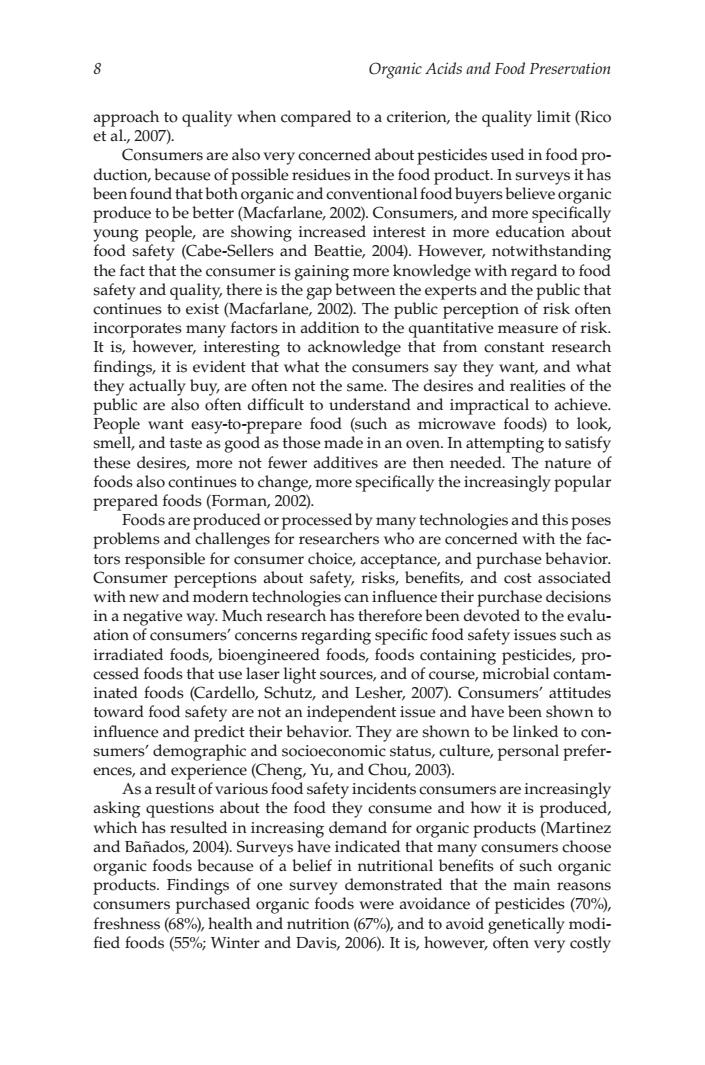正在加载图片...

Organic Acids and Food Preservation oach to quality when compared to a criterion,the quality limit(Rico aPp 2007) et Consumersare also very concerned about pesticides used in food pro- duction,because of possible residues in the food product.In surveys it has been found that both organic and conventional food buyers believe organic produce to be better(Macfarlane,2002).Consumers,and more specifically young people,are showing increased interest in more education about food safety (Cabe-Sellers and Beattie,2004).However,notwithstanding the fact that the c umer is gaining more knowledge e with safety and quality, en th continues to exi Macfarlane ofte incorporates many factors in addition to the quantitative measure of rish It is,however,interesting to acknowledge that from constant research findings,it is evident that what the consumers say they want,and what they actually buy,are often not the same.The desires and realities of the public are also often difficult to understand and impractical to achieve. People want easy-to-p repare food (such as microwave foods)to look smell.and taste as good as those made in an oven.In atte pting to satisfy the desires, more not fewer additives needed nature ,more specifically the increasingly popular prepared foods(Forman,2002). Foods are produced or processed by many technologies and this poses problems and challenges for researchers who are concerned with the fac- tors responsible for consumer choice.acceptance.and purchase behavior Consumer perceptions about safety,risks,benefits,and cost associated with new and modern technologie can influe ce their purchase decisic in way.Much research has therefo h concerns regardi ng specific fo irradiated foods,bioengineered foods,foods containing pesticides,pro- cessed foods that use laser light sources,and of course,microbial contam- inated foods(Cardello.Schutz.and Lesher.2007).Consumers'attitudes toward food safety are not an independent issue and have been shown to influence and predict their behavior.They are shown to be linked to con- sumers'demog aphic and socioe ic status,culture,personal prefer- en and ,and Chou,2003) ask As a res ty incide ents con ers are ncreas ngly ng questio bout the food t they consume and how it is produced which has resultec d in increasing demand for organic products(Martinez and banados,2004).Surveys have indicated that many consumers choose organic foods because of a belief in nutritional benefits of such organic products.Findings of one survey demonstrated that the main reasons consumers purchased organic foods were avoidance of pesticides(70%), freshness(68%),health and nutrition(67%),and to avoid fied foo etically modi- ods (55%;Winter and Davis,2006).It is,however,often very costly8 Organic Acids and Food Preservation approach to quality when compared to a criterion, the quality limit (Rico et al., 2007). Consumers are also very concerned about pesticides used in food production, because of possible residues in the food product. In surveys it has been found that both organic and conventional food buyers believe organic produce to be better (Macfarlane, 2002). Consumers, and more specifically young people, are showing increased interest in more education about food safety (Cabe-Sellers and Beattie, 2004). However, notwithstanding the fact that the consumer is gaining more knowledge with regard to food safety and quality, there is the gap between the experts and the public that continues to exist (Macfarlane, 2002). The public perception of risk often incorporates many factors in addition to the quantitative measure of risk. It is, however, interesting to acknowledge that from constant research findings, it is evident that what the consumers say they want, and what they actually buy, are often not the same. The desires and realities of the public are also often difficult to understand and impractical to achieve. People want easy-to-prepare food (such as microwave foods) to look, smell, and taste as good as those made in an oven. In attempting to satisfy these desires, more not fewer additives are then needed. The nature of foods also continues to change, more specifically the increasingly popular prepared foods (Forman, 2002). Foods are produced or processed by many technologies and this poses problems and challenges for researchers who are concerned with the factors responsible for consumer choice, acceptance, and purchase behavior. Consumer perceptions about safety, risks, benefits, and cost associated with new and modern technologies can influence their purchase decisions in a negative way. Much research has therefore been devoted to the evaluation of consumers’ concerns regarding specific food safety issues such as irradiated foods, bioengineered foods, foods containing pesticides, processed foods that use laser light sources, and of course, microbial contaminated foods (Cardello, Schutz, and Lesher, 2007). Consumers’ attitudes toward food safety are not an independent issue and have been shown to influence and predict their behavior. They are shown to be linked to consumers’ demographic and socioeconomic status, culture, personal preferences, and experience (Cheng, Yu, and Chou, 2003). As a result of various food safety incidents consumers are increasingly asking questions about the food they consume and how it is produced, which has resulted in increasing demand for organic products (Martinez and Bañados, 2004). Surveys have indicated that many consumers choose organic foods because of a belief in nutritional benefits of such organic products. Findings of one survey demonstrated that the main reasons consumers purchased organic foods were avoidance of pesticides (70%), freshness (68%), health and nutrition (67%), and to avoid genetically modified foods (55%; Winter and Davis, 2006). It is, however, often very costly